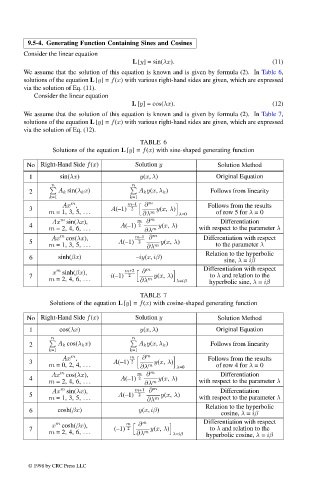Page 496 - Handbook Of Integral Equations
P. 496
9.5-4. Generating Function Containing Sines and Cosines
Consider the linear equation
L [y] = sin(λx). (11)
We assume that the solution of this equation is known and is given by formula (2). In Table 6,
solutions of the equation L [y]= f(x) with various right-hand sides are given, which are expressed
via the solution of Eq. (11).
Consider the linear equation
L [y] = cos(λx). (12)
We assume that the solution of this equation is known and is given by formula (2). In Table 7,
solutions of the equation L [y]= f(x) with various right-hand sides are given, which are expressed
via the solution of Eq. (12).
TABLE 6
Solutions of the equation L [y]= f(x) with sine-shaped generating function
No Right-Hand Side f(x) Solution y Solution Method
1 sin(λx) y(x, λ) Original Equation
2 n A k sin(λ k x) n A k y(x, λ k ) Follows from linearity
k=1 k=1
m m–1 m
Ax , ∂ Follows from the results
3 A(–1) 2 y(x, λ)
m = 1,3,5, ... ∂λ m λ=0 of row 5 for λ =0
m m ∂ m
Ax sin(λx), Differentiation
4 A(–1) 2 y(x, λ)
m = 2,4,6, ... ∂λ m with respect to the parameter λ
m
Ax cos(λx), m–1 ∂ m Differentiation with respect
5 A(–1) 2 y(x, λ)
m = 1,3,5, ... ∂λ m to the parameter λ
Relation to the hyperbolic
6 sinh(βx) –iy(x, iβ)
sine, λ = iβ
m
x sinh(βx), m+2 ∂ m Differentiation with respect
7 i(–1) 2 y(x, λ) to λ and relation to the
m = 2,4,6, ... ∂λ m λ=iβ hyperbolic sine, λ = iβ
TABLE 7
Solutions of the equation L [y]= f(x) with cosine-shaped generating function
No Right-Hand Side f(x) Solution y Solution Method
1 cos(λx) y(x, λ) Original Equation
2 n A k cos(λ k x) n A k y(x, λ k ) Follows from linearity
k=1 k=1
m
Ax , m ∂ m Follows from the results
3 A(–1) 2 y(x, λ)
m = 0,2,4, ... ∂λ m λ=0 of row 4 for λ =0
m
Ax cos(λx), m ∂ m Differentiation
4 A(–1) 2 y(x, λ)
m = 2,4,6, ... ∂λ m with respect to the parameter λ
m
Ax sin(λx), m+1 ∂ m Differentiation
5 A(–1) 2 y(x, λ)
m = 1,3,5, ... ∂λ m with respect to the parameter λ
Relation to the hyperbolic
6 cosh(βx) y(x, iβ)
cosine, λ = iβ
m
x cosh(βx), m ∂ m Differentiation with respect
7 (–1) 2 y(x, λ) to λ and relation to the
m = 2,4,6, ... ∂λ m λ=iβ hyperbolic cosine, λ = iβ
© 1998 by CRC Press LLC
© 1998 by CRC Press LLC
Page 478

